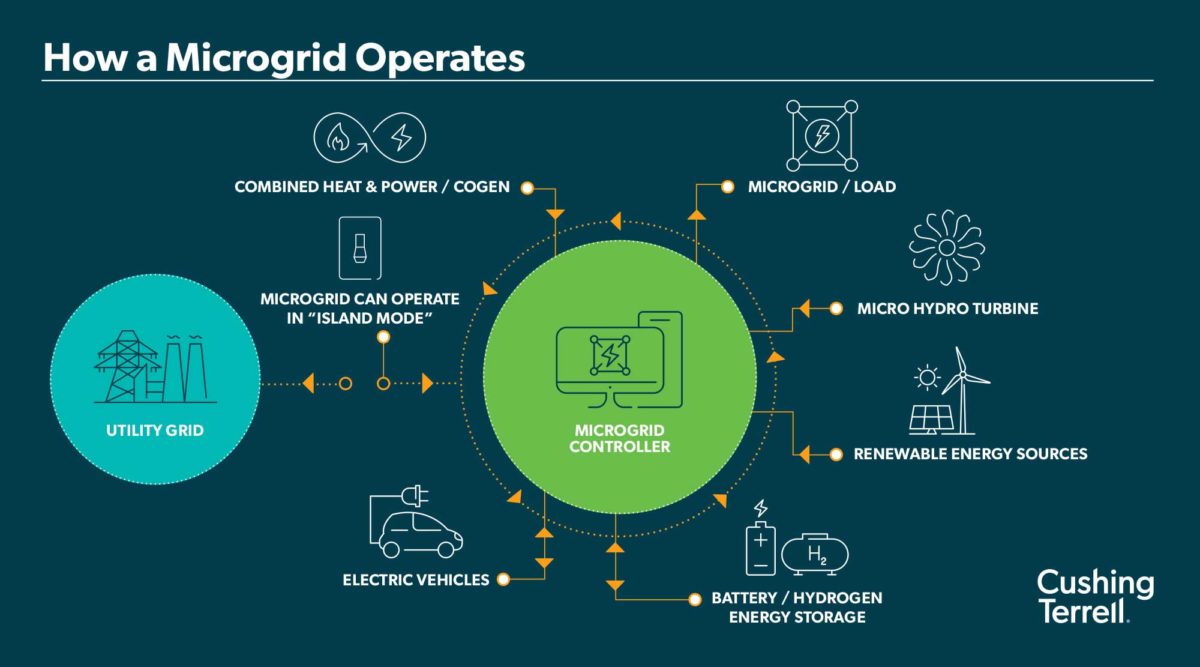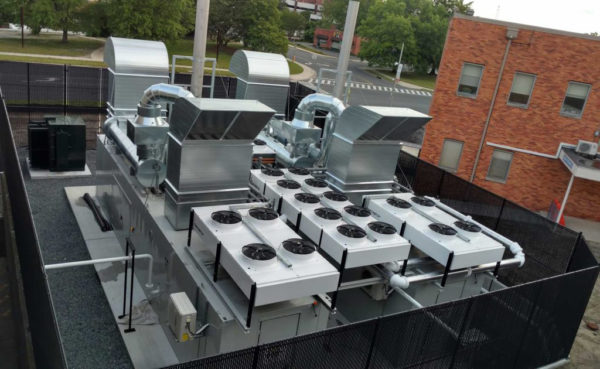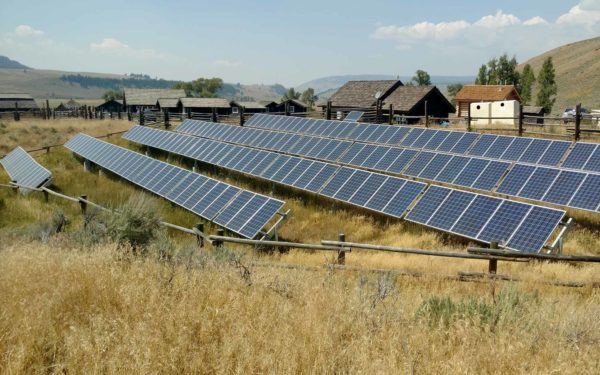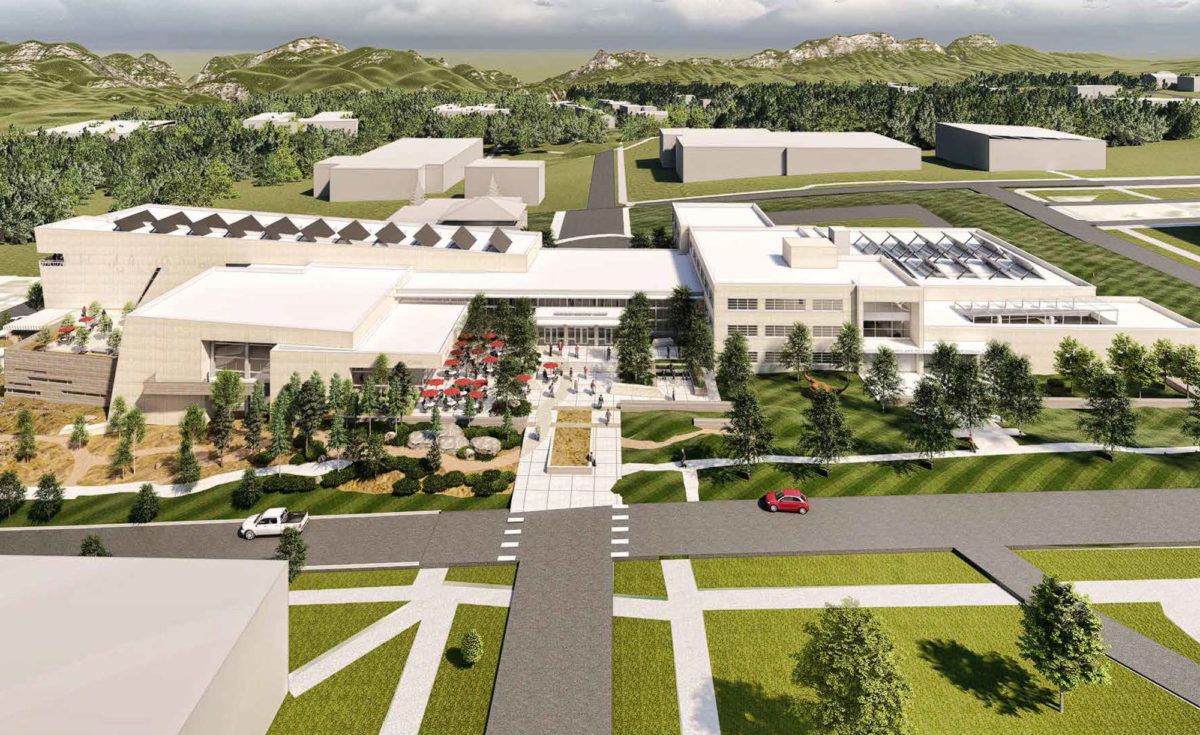With a traditional utility grid, electricity is generated at central power plants and transported over long distances. Buildings and municipalities connect to this power through a series of substations and transmission lines. With few redundant paths for energy to be delivered, thousands of users can be left without power if one part of the grid fails or needs to be repaired.

In contrast, a microgrid uses local energy sources to generate power for individual buildings or a campus of buildings. Microgrids can operate autonomously (in “island mode”) or be connected to the larger utility grid, making it more adaptable and resilient.
When a microgrid connects to the primary grid, it parallels the grid, matching its characteristics, such as voltage, frequency, and phase rotation. Depending upon the generation capacity, in circumstances such a partial shutdown of a central power plant, utilities can use the microgrid as a back-up generation source.
Some of the local, distributed energy resources utilized by microgrids can include engine generators and/or renewable sources, such as solar, wind, or hydropower. Many newer microgrids also incorporate energy storage and electric vehicle charging stations.

Who might consider a microgrid system?
Grocery stores that depend on large refrigeration systems for their products and hospitals that must keep life-saving/sustaining equipment and HVAC systems running at all times are two prime examples.
For ShopRite grocery stores on the East Coast, our Cushing Terrell team configured combined heat and power microgrid systems that generate power using a lean-burn, natural-gas engine. Set up to operate in island mode, when Hurricane Isaias hit in August 2020, the stores remained operating and were able to keep frozen and refrigerated goods from perishing, saving millions of dollars for this particular client.
Additionally, you can see this type of system in action for the Peninsula Regional Medical Center in Maryland. Two large, highly efficient natural-gas engines produce power for the hospital at all times. The system recaptures waste heat off the engines and pipes it into the boiler system, reducing the amount of natural gas burned in boilers to heat the hospital. This combined heat and power system can be placed in island mode, so if the utility grid goes down due to a hurricane or other outage, the hospital can disconnect from the main grid and keep running.

Image: Cushing Terrell
Some microgrids aren’t attached to a larger grid at all. These are typically found in very rural settings where extending power from a central hub would be too difficult or expensive.
For example, Cushing Terrell designed the Lamar Buffalo Ranch power system in Yellowstone National Park, which uses a solar photovoltaic array, micro-hydro turbine, Toyota recycled nickel-metal hybrid car batteries, and a small propane back-up generator. The system allows the facility to operate in a way that conserves energy and water, and reduces waste. Toyota sponsored this project in an effort to find a secondary use for hybrid car batteries after they reached the end of their life in a vehicle.

Image: Cushing Terrell
Image: Cushing Terrell
Not all microgrids are considered greener, as many are powered by diesel generators, but more and more organizations are using renewables to power their microgrids. Environmentally friendly energy sources such as wind and solar are variable, meaning they ramp up and down based on nature’s schedule. However, when paired with the central grid or integrated into a form of storage (batteries, pumped hydro, or hydrogen), the swings that can occur with renewables are balanced out.
The Lamar Buffalo Ranch Power System in Yellowstone National Park is 100% off-grid.
Why all the buzz?
More companies and governments are considering microgrids as the solution to a variety of challenges. There’s evidence that microgrids could reduce safety concerns, propel the use of electric vehicles, eliminate transmission losses, and even enable a more robust sharing economy.
Failed power lines due to high-wind events can leave customers without power and, even worse, cause large wildfires. We saw recent examples of this in California where wildfires devastated homes and communities. To address these natural disasters, local utilities have begun to de-energize power lines during high-wind events, which can result in hundreds of thousands of customers without power for a few hours to several days.
Microgrids have the potential to help with this situation in two ways. First, local power sources can eliminate the need for such long-distance delivery, thus reducing the potential for a power line to spark or short out in a dry zone. Second, if power lines do need to be shut down in anticipation of a high-wind event, the microgrid can switch to island mode instead of relying on power served from these lines. This can result in health, safety, and economic benefits when it comes to power needed for medical equipment and keeping refrigerated and frozen goods from perishing during extended outages.
Wildfires are not the only natural disaster that demonstrates the fragility of the utility grid. With climate change causing more frequent superstorms like the recent hurricanes on the East Coast, aging traditional energy infrastructure (power lines and substations) can be damaged or destroyed. It can take anywhere from a couple of days to several weeks after these storms pass to restore power to the areas affected. However, microgrids that operate independently from the primary grid can continue operating during these events. An example of this independence is the continued operation of ShopRite grocery stores on the East Coast during Tropical Storm Isaias.
Electric vehicles (EV) also benefit from microgrids, and vice versa. Microgrids can better power EV charging stations, while EV popularity can drive interest in microgrids. EV charging structures — especially fast chargers — can exceed the capacity of utility substations and distribution lines, meaning that utilities may need to update distribution infrastructure to meet this increased demand.
Microgrids are especially important as businesses and public transit authorities electrify their fleets. If the existing electrical distribution grid can’t accommodate the energy loads necessary to power a fleet, microgrids can help with power availability and offer cost control and predictability. Additionally, microgrids can ensure a percentage of the power going into these fleets is from renewables or low-carbon sources. In the future, EVs could start to play a role as an energy-storage device with the potential to release energy back to the grid when not being used for transportation.
Peer-to-peer trading
The sharing economy has reached utilities. The New York Times reported on one such microgrid in — where else? — Brooklyn. In this example, the microgrid is a virtual, peer-to-peer energy trading system built on blockchain. With peer-to-peer energy trading, residents and businesses have control over the energy that’s produced in their microgrid, rather than an energy company. They use a virtual trading
platform that allows solar-energy producers to sell excess-electricity credits from their systems to buyers in the group.
They’re not the only group engaging in this approach, as neighbor-based systems exist in Australia, India, Germany and elsewhere, with members trading their stored energy (typically generated via solar panels) among one another.
***
Nathan Bronec specializes in energy production modeling, power distribution and generation, alternative energy systems, and the financial analysis of power generation systems. In his seven years with Cushing Terrell, his work has included unique projects such as the Lamar Buffalo Ranch off-grid site and grid-scale solar farms.
The views and opinions expressed in this article are the author’s own, and do not necessarily reflect those held by pv magazine.
This content is protected by copyright and may not be reused. If you want to cooperate with us and would like to reuse some of our content, please contact: editors@pv-magazine.com.








By submitting this form you agree to pv magazine using your data for the purposes of publishing your comment.
Your personal data will only be disclosed or otherwise transmitted to third parties for the purposes of spam filtering or if this is necessary for technical maintenance of the website. Any other transfer to third parties will not take place unless this is justified on the basis of applicable data protection regulations or if pv magazine is legally obliged to do so.
You may revoke this consent at any time with effect for the future, in which case your personal data will be deleted immediately. Otherwise, your data will be deleted if pv magazine has processed your request or the purpose of data storage is fulfilled.
Further information on data privacy can be found in our Data Protection Policy.